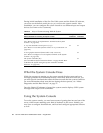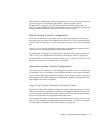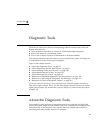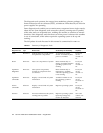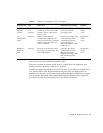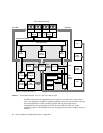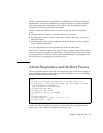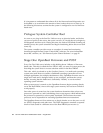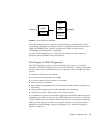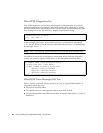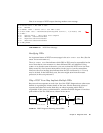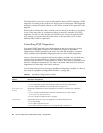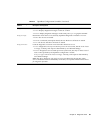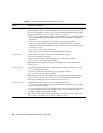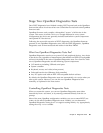
78 Sun Fire V490 Server Administration Guide • August 2004
It is important to understand that almost all of the firmware-based diagnostics can
be disabled so as to minimize the amount of time it takes the server to start up. In
the following discussion, assume that the system is configured to run its firmware-
based tests.
Prologue: System Controller Boot
As soon as you plug in the Sun Fire V490 server to an electrical outlet, and before
you turn on power to the server, the system controller (SC) inside the server begins its
self-diagnostic and boot cycle. During this time, the locator LED blinks. Running off
standby power, the system controller card begins functioning before the server itself
comes up.
The system controller provides access to a number of control and monitoring
functions through Remote System Control (RSC) software. For more information
about RSC software, see “Sun Remote System Control Software” on page 22.
Stage One: OpenBoot Firmware and POST
Every Sun Fire V490 server includes a chip holding about 2 Mbytes of firmware-
based code. This chip is called the Boot PROM. After you turn on system power, the
first thing the system does is execute code that resides in the Boot PROM.
This code, which is referred to as the OpenBoot firmware, is a small-scale operating
system unto itself. However, unlike a traditional operating system that can run
multiple applications for multiple simultaneous users, OpenBoot firmware runs in
single-user mode and is designed solely to test, configure, and boot the system,
thereby ensuring that the hardware is sufficiently “healthy” to run its normal
operating system software.
When system power is turned on, the OpenBoot firmware begins running directly
out of the Boot PROM, since at this stage system memory has not been verified to
work properly.
Soon after power is turned on, the system hardware determines that at least one
processor is powered on, and is submitting a bus access request, which indicates that
the processor in question is at least partly functional. This becomes the master
processor, and is responsible for executing OpenBoot firmware instructions.
The OpenBoot firmware’s first actions are to check whether to run the power-on self-
test (POST) diagnostics and other tests. The POST diagnostics constitute a separate
chunk of code stored in a different area of the Boot PROM (see
FIGURE 6-2).



